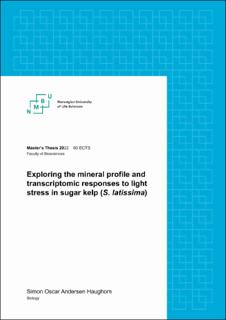| dc.contributor.advisor | Rao Kovi, Mallikarjuna | |
| dc.contributor.advisor | Saavedra Goecke, Franz Ronald | |
| dc.contributor.advisor | Mydland, Liv Torunn | |
| dc.contributor.advisor | Ergon, Åshild Gunilla | |
| dc.contributor.author | Haughom, Simon Oscar Andersen | |
| dc.date.accessioned | 2023-01-04T13:07:11Z | |
| dc.date.available | 2023-01-04T13:07:11Z | |
| dc.date.issued | 2022 | |
| dc.identifier.uri | https://hdl.handle.net/11250/3040965 | |
| dc.description.abstract | The macroalgae industry is growing and sugar kelp (Saccharina latissima) has become a popular choice for cultivation. One of the challenges for the species as a product for human consumption and animal feed is high contents of iodine and arsenic. Iodine is an important antioxidant in brown macroalgae, and decreased iodine content in S. latissima individuals could inflict reduced stress tolerance.
Mineral content was investigated in relation to thallus part, depth, thallus size, and ash percentage in cultivated S. latissima. A transcriptome analysis was performed on S. latissima samples from an earlier light stress experiment performed at Sintef Ocean Trondheim as part of the SafeKelp project.
Comparisons between stipe and bottom samples showed that many inorganic elements have different concentrations in the stipe and bottom (but not iodine). Iodine, arsenic, phosphorus, and vanadium levels were significantly correlated with rope section (depth) in bottom samples, and bromine and phosphorus were significantly related to ash content. Thallus size (fresh weight) tended to increase in individuals growing closer to the surface, but the relationship was not significant.
Proteins presumed to be vanadium-dependent iodoperoxidase (vIPO) and vanadiumdependent bromoperoxidases vBPO was upregulated in samples treated with 250 µmol m-2 s -1 light, but efflux of iodine or bromine content was not observed in these samples. Arsenic and lead contents decreased with time at 250 µmol m-2 s -1 light exposure. The metal complexing protein glutathione S-transferase was upregulated for samples exposed to 250 µmol light (days 1, 3, and 9). Various other stress related processes were observed to be regulated in the treated samples compared to control, including the xanthophyll cycle, base-excision repair, and peroxisome activity. | en_US |
| dc.language.iso | eng | en_US |
| dc.publisher | Norwegian University of Life Sciences, Ås | en_US |
| dc.rights | Attribution-NonCommercial-NoDerivatives 4.0 Internasjonal | * |
| dc.rights.uri | http://creativecommons.org/licenses/by-nc-nd/4.0/deed.no | * |
| dc.title | Exploring the mineral profile and transcriptomic responses to light stress in sugar kelp (S. latissima) | en_US |
| dc.type | Master thesis | en_US |
| dc.description.localcode | M-BIOL | en_US |

